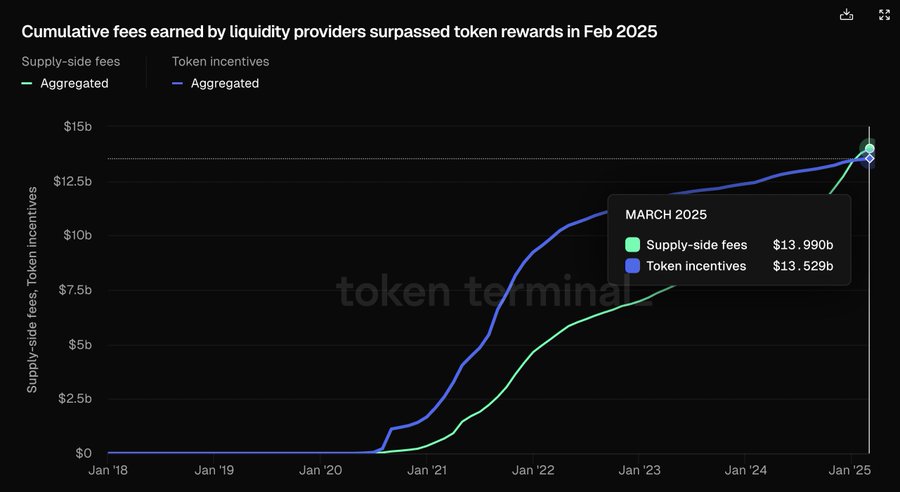- DeFi has traded its token trinkets for the cold, hard cash of fee-based rewards, proving that even blockchain has a price tag.
- This shift isn’t just maturity—it’s DeFi’s midlife crisis, complete with institutional investors and a desperate need for stability.
Decentralized finance, that darling of the digital age, is undergoing a transformation so profound it might as well be called a glow-up. Gone are the days of token incentives, those shiny baubles that lured liquidity providers like moths to a flame. Now, the real money is in protocol fees—because nothing says “sustainability” like charging people for the privilege of using your platform.
Liquidity providers, once seduced by the siren song of token rewards, are now finding their fortunes in the more mundane but infinitely more reliable world of fees. This shift marks a new era for DeFi, one where stability and long-term growth are the new black, and short-term incentives are so last season.
As the sector grows up (finally), this change could redefine the economic landscape of decentralized finance, creating an ecosystem that’s as resilient as it is profitable. Or, at the very least, less likely to collapse at the first sign of trouble.
The traditional DeFi model: A cautionary tale
In the halcyon days of DeFi, platforms relied on token incentives like airdrops, governance tokens, and yield farming to attract liquidity. It was a wild, untamed frontier, with platforms like Uniswap, Sushiswap, and Compound leading the charge. But, as with all things built on hype, the party couldn’t last forever.
Once the incentives dried up or token prices plummeted, liquidity providers fled faster than a cat from a bathtub. This “farm-and-dump” behavior, while effective in the short term, raised serious concerns about the long-term stability of DeFi ecosystems. After all, what good is liquidity if it disappears the moment the freebies stop?
Transition to fee-based earnings: The rise of the cash cow
The DeFi landscape is now seeing a seismic shift from token incentives to fee-based earnings. It’s a move so bold it might as well come with a mic drop.

Data shows that cumulative supply-side fees surpassed token rewards in February 2025, with supply-side fees climbing to $13.99 billion, compared to $13.53 billion in token incentives by March 2025. This marks a significant departure from the traditional model, where token incentives were the bread and butter of earnings.
Now, platforms are increasingly generating revenue through protocol fees, including transaction fees, staking rewards, and yield farming driven by protocol activity. This transition is a sign that DeFi protocols are finally growing up, moving towards a self-sustaining model that doesn’t rely on the whims of token prices.
Why this shift signals DeFi maturity: Or, how DeFi got its act together
As DeFi protocols rely more on transaction fees, staking rewards, and yield farming, the ecosystem becomes more stable and sustainable. Unlike the token-driven models that caused volatility worthy of a soap opera, fee-based structures offer more consistent returns. This shift reflects DeFi’s maturity, with protocols finally able to handle market fluctuations and provide reliable returns for liquidity providers.
Platforms with strong fee structures are attracting long-term participants, reducing speculative behavior and the dreaded “farm-and-dump” risks. As protocols build self-sustaining revenue streams, they become more attractive to institutional investors, who are always on the lookout for predictable returns. After all, even the most adventurous investor likes a sure thing now and then.
What’s next for DeFi? The plot thickens…
Read More
- Who Is Harley Wallace? The Heartbreaking Truth Behind Bring Her Back’s Dedication
- 50 Ankle Break & Score Sound ID Codes for Basketball Zero
- 50 Goal Sound ID Codes for Blue Lock Rivals
- Elden Ring Nightreign Enhanced Boss Arrives in Surprise Update
- KPop Demon Hunters: Real Ages Revealed?!
- 100 Most-Watched TV Series of 2024-25 Across Streaming, Broadcast and Cable: ‘Squid Game’ Leads This Season’s Rankers
- How to play Delta Force Black Hawk Down campaign solo. Single player Explained
- Here’s Why Your Nintendo Switch 2 Display Looks So Blurry
- MrBeast removes controversial AI thumbnail tool after wave of backlash
- Mirren Star Legends Tier List [Global Release] (May 2025)
2025-03-29 20:11